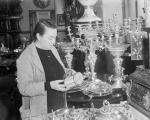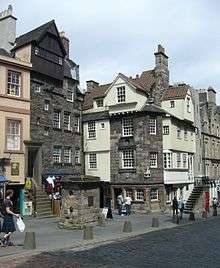Esta Henry
Esta Henry or Esther Henry (1883–1963) was an antique dealer in Edinburgh, Scotland. Born in Newcastle-upon-Tyne, in her time she was the subject of news stories in many countries and known for her eccentric behavior. Sometimes called "Mrs. Scotland"[1] in the press, she had ties to a number of notable people and events, including British queens and the auction of the collections of King Farouk of Egypt.
Esta Henry | |
|---|---|
 Esta Henry in her shop | |
| Born | 1883 Newcastle-upon-Tyne |
| Died | 1963 (aged 80) São Paulo, Brazil |
| Other names | Esther Henry |
| Occupation | Antique dealer |
Henry's shop

Henry ran an antiques business out of a shop called The Luckenbooth[2][3] in Moubray House, the oldest building on the Royal Mile in Edinburgh. A luckenbooth is a heart-shaped Scottish brooch named for the shops in the Luckenbooths tenements where jewelry was once sold. Moubray House is next to the John Knox House[1] and is the oldest occupied building in the city. Most records state that Robert Moubray built the original house in 1477. The property itself has gone through many rebuilds and renovations and was gifted to Historic Scotland, the association responsible for historic monuments, in 2012.[4]
The antique shop on the Royal Mile was "a favourite haunt" of Queen Mary (Mary of Teck), and visited by the Queen (Queen Elizabeth The Queen Mother) and Princess Margaret, in 1948. During the visit, Esta Henry took them to see the flat above the shop in Moubray House, where the Queen Mother said she "would like to live on the Royal Mile".[5]
Jewelry theft
On 1 May 1953, £650 of the "Hungarian crown jewels collection" was stolen from Henry's shop. The gems were later found at 22 St. Stephen's road in Canterbury. Henry agreed to pay £15 to the owner of the shop, Barnett Lee, to recover her property. The aquamarine, diamond and platinum brooch was sold to Lee (in parts) for £60, by one of two men who had been sentenced at the High Court in Edinburgh for the theft.[6]
It is possible that these items were stolen from Henry by Archibald Hall, alias Roy Fontaine. Although he was caught and jailed for his crimes, Hall used the proceeds of his thefts in Scotland to move to London. In England he became infamous for infiltrating high class society, committing robberies, and killing a number of his targets. In 1978, Hall was found guilty of murder and sentenced to two life-terms. He died in Kingston Prison, Portsmouth in 2002. A screenplay for a film about Hall, called Monster Butler, was written by Peter Bellwood.[7]
According to A. M. Nicol in the 2011 book, The Monster Butler, Hall claimed that he planned the theft that was Scotland's biggest jewel robbery. He devised a scheme with his accomplice, John Wootton, whom he met in prison. Together they took approximately £100,000 in goods from a tin box at the back of Henry's shop and went to Torquay. After hiding some of the jewels, they were arrested and sent to Edinburgh. Nicol writes, "the prosecution offered them a deal which involved the true value of the jewels not being made public". Nicol posits that Hall's story is a fabrication and the actual was an "opportunistic sneak theft" for a great deal less value.[8]
King Farouk's auction
Farouk I of Egypt was the king of Egypt and Sudan, following his father Fuad I of Egypt, in 1936. He was known for his extensive collection including decorated horological instruments, coins and pornographic art. In 1952, Farouk was deposed by the Egyptian government. His collections were auctioned in February 1954[9] to return the money spent by Farouk to Egypt's treasury. News of the auction was reported throughout the world, and Henry was the subject of a number of these articles.[10][11]
The auction was run by the new government, not professional auctioneers, which resulted in unusual circumstances. During the auction, Henry protested that she could not see and left the salesroom; the supervisors followed her to make amends. Two days earlier, Henry insisted that they conduct the auction in English as well as French and Egyptian, and they complied.[12] At one point Henry grabbed a clock from the stand in the middle of bidding,[13] "When I saw it I rushed up and shouted, lay off—this is for Scotland. If any twister breaks my bid I'll break his neck."[1]
Henry spent over 10,000 pounds sterling at the auction held at the Koubbeh Palace in Cairo,[1] and purchased some items made in Britain; "It gives me pleasure to see rare treasures in their rightful places", she said. One of these was a star shaped watch made by David Ramsay in the 17th century.[1]
During the trip, Henry spoke to a group of women who were holding a starvation strike at the Cairo Press Club to gain the right to vote. The women were members of Daughters of the Nile (Bint El Nil), led by 36-year-old Doria Shafik.[14]
They tried to get me to talk politics. All I said was, 'I believe in Scotland for the Scots, England for the English, Egypt for the Egyptians, and equal rights for women.'
— Esta Henry, The Sydney Morning Herald[1]
Personal life
Henry claimed to have started in the antique business 'shoving a hawker's barrow out of Jane Street'[15] at the age of 9, "I started with a pushbike and 30 bob, I lived in one room which was also the shop."[1]
Henry performed secret acts of charity to local families, and was elected councillor to Edinburgh of one of the Canongate wards in 1936. Although she was Jewish, Henry had campaigned under a Protestant Action banner, supporting Protestant leader John Cormack.[3][16][17] Shortly after her election Cormack announced he and Henry would stand for Parliament at the next UK general election, but in fact Henry soon left Protestant Action.[18] Tom Gallagher believes Henry was not anti-Catholic, but joined Protestant Action as a means to become a councillor. Kenneth Baxter concurs with this view noting among other evidence the facts that she had previously sought election to Edinburgh Council as 'Moderate/Progressive' candidate without success on five previous occasions and in October 1936 had been intending to stand as an 'Independent Progressive'.[19]
Henry was widowed in 1947 at the age of 64, and left with 2 daughters and 3 sons.[20]
In 1953, a Romanian art dealer named Pinchas Haimovici was held in Saughton Prison, Edinburgh, pending deportation for entering the country on a false passport with the name Paul Eugene Dillon (a Belgian named Paul Dijon in other sources[3]).[20] Esta Henry previously met Haimovici, who was 20 years her junior, when he came into her shop in Moubray House. She did not believe his claims and determined to help him, after which he surrendered voluntarily to the court.[3][20] After his release by the Sheriff Court, he was arrested again as an alien to be deported. Haimovici appealed the order made by the Home Secretary, claiming that he would be put to death as anti-Communist if he was returned to Romania.[21] Henry declared that she "loved Paul" and she would marry him and take care of all his financial needs (presumably to legalize his position in Scotland).[20] They married shortly after his second release and Haimovici changed his name to Paul Henry.[22]
Sculptor Benno Schotz created a piece called Paul and Esta Henry, shown at the Royal Academy of Arts in 1954.[23][24]
Esta and Paul Henry died on 17 January 1963, in an air crash in São Paulo, Brazil, returning from a "belated honeymoon".[3] Henry's antiques were taken over by her son Louis Henry.[25]
References
- Kitchener, Pamela (3 August 1958). "'Mrs Scotland' has an eye for a royal bargain". Sydney. The Sydney Morning Herald. p. 39. Retrieved 12 April 2013.
- Gallagher, Tom (1987). Edinburgh divided: John Cormack and no popery in the 1930's. Polygon. pp. 111, 147. ISBN 9780948275401.
- Campbell, Donald (2003). Edinburgh: A Cultural and Literary History. Signal Books. p. 277. ISBN 9781902669731.
- "Edinburgh's Moubray House to be gifted to Historic Scotland". BBC. 25 August 2012. Retrieved 16 April 2013.
- "Royal Family Leave Edinburgh". Glasgow, Scotland. The Glasgow Herald. 6 July 1948. p. 3. Retrieved 12 April 2013.
- "£15 To Recover Stolen Gems". Glasgow. The Glasgow Herald. 19 December 1953. p. 7. Retrieved 14 April 2013.
- McGinty, Stephen (17 November 2012). "Shortage of cash proves fatal for serial killer film 'Monster Butler'". Scotsman. Retrieved 14 April 2013.
- Nicol, A.M. (2011). The Monster Butler (PDF). Black & White Publishing. pp. 10–11, 69–74. ISBN 9781845023362.
- "Cairo" (Press release). The Numismatist. January 1954. Retrieved 12 April 2013.
- British Broadcasting Corporation (1962). "'Auld Reekie'". London Calling. 2 (240–303): 239.
- Herrmann, Frank (1980). Sotheby's, portrait of an auction house. Chatto & Windus.
- "They chased her around Cairo to sell her Farouk's antiques". The Straits Times. 13 March 1954. p. 3. Retrieved 21 April 2013.
- "She took her time". Australian Associated Press. 15 March 1954. p. 15. Retrieved 21 April 2013.
- "Pep Talk". Perth. The West Australian. 16 March 1954. p. 2. Retrieved 14 April 2013.
- Holmes McDougall (1985). "Edinburgh". Scottish Field. 131.
- Gallagher, T. (1987). Glasgow: The Uneasy Peace : Religious Tension in Modern Scotland, 1819–1914. Manchester University Press. p. 165. ISBN 9780719023965.
- Cooke, Anthony; Donnachie, Ian (1998). Readings 1850 to the Present Volume 4 of Modern Scottish History 1707 to the Present. Tuckwell Press, in association with the Open University in Scotland and the University of Dundee. p. 186. ISBN 9781862320833.
- Kenneth Baxter (2014). "Gender, Militant Protestantism and Local Politics in Interwar Scotland". In Macdonald, Stuart; MacLeod, Daniel (eds.). Keeping the Kirk Scottish Religion at Home and in the Diaspora. Guelph: Centre for Scottish Studies, University of Guelph. p. 205.
- Kenneth Baxter (2014). "Gender, Militant Protestantism and Local Politics in Interwar Scotland". In Macdonald, Stuart; MacLeod, Daniel (eds.). Keeping the Kirk Scottish Religion at Home and in the Diaspora. Guelph: Centre for Scottish Studies, University of Guelph. p. 219.
- "Widow of 70, and Her 'Love for Paul'". Singapore. The Singapore Free Press. 8 January 1953. p. 3. Retrieved 14 April 2013.
- "Roumanian (sic) Art Dealer Freed". Glasgow. The Glasgow Herald. 25 April 1953. p. 7. Retrieved 12 April 2013.
- "He quits gaol-and finds his bride". Singapore. The Singapore Free Press. 5 May 1953. p. 7. Retrieved 16 April 2013.
- Royal Academy of Arts (Great Britain) (1973). Royal Academy exhibitors, 1905–1970: a dictionary of artists and their work in the summer exhibitions of the Royal Academy of Arts, Volume 5. EP Publishing. p. 458. ISBN 9780854099870.
- "Edinburgh". The Scots Magazine. 61: 291. 1954.
- "Items Withdrawn at Antique Fair". Glasgow. The Glasgow Herald. 1 May 1963. p. 15. Retrieved 12 April 2013.